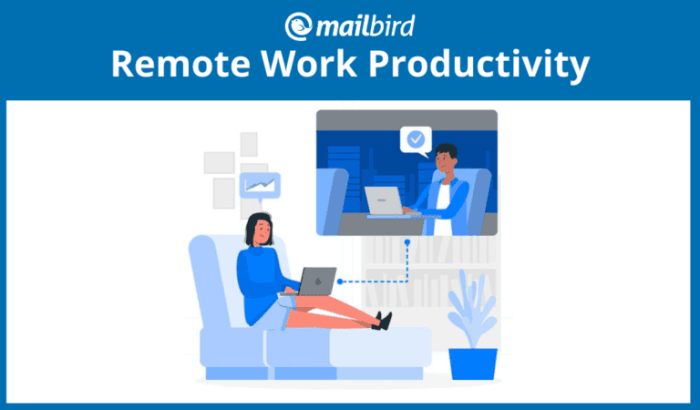Remote Work Productivity: As the buzz around remote work productivity grows, dive into a world where efficiency meets flexibility, promising a dynamic work experience like no other.
Get ready to explore the ins and outs of maximizing productivity while working remotely, uncovering key strategies and insights along the way.
Overview of Remote Work Productivity

Remote work productivity refers to the level of efficiency and effectiveness at which individuals or teams can complete tasks and achieve goals while working remotely, outside of a traditional office setting. This includes managing time, staying focused, collaborating with colleagues, and delivering high-quality work, all while being physically separated from coworkers.
In today’s work environment, remote work productivity has become increasingly important due to the rise of telecommuting and flexible work arrangements. With advancements in technology and communication tools, more companies are embracing remote work as a way to increase employee satisfaction, reduce overhead costs, and tap into a global talent pool.
Studies have shown that remote work productivity can have a significant impact on businesses. According to a report by FlexJobs, 65% of employees believe they would be more productive working remotely than in a traditional office setting. Additionally, a study by Stanford University found that remote workers experienced a 13% increase in productivity compared to their in-office counterparts.
The Benefits of Remote Work Productivity
- Flexibility to work from anywhere
- Reduced commute time and stress
- Increased focus and fewer distractions
- Improved work-life balance
- Access to a diverse talent pool
Challenges of Remote Work Productivity
Working remotely comes with its own set of challenges that can impact productivity. Let’s dive into some common hurdles employees face and how to overcome them.
Distractions at Home
One major challenge of remote work is dealing with distractions at home. Whether it’s noisy neighbors, household chores calling your name, or family members interrupting your flow, staying focused can be tough.
- Create a designated workspace: Set up a dedicated area in your home where you can work without distractions.
- Establish boundaries: Let your family or housemates know your work hours and when you shouldn’t be disturbed.
- Use noise-canceling headphones: Block out external noise to stay focused on your tasks.
- Take breaks: Schedule short breaks to rest your mind and prevent burnout.
Lack of Face-to-Face Interaction
Another challenge of remote work is the lack of face-to-face interaction with colleagues. This can lead to feelings of isolation and hinder collaboration and communication.
- Schedule virtual meetings: Use video conferencing tools to connect with your team and maintain communication.
- Participate in virtual team building activities: Engage in online team building exercises to foster camaraderie and strengthen relationships.
- Reach out for help: Don’t hesitate to reach out to your colleagues or managers for support and guidance when needed.
Benefits of Remote Work Productivity
Working remotely offers numerous advantages that can significantly enhance productivity, flexibility, and work-life balance for individuals. Let’s explore some of the key benefits below.
Increased Productivity
- Remote work eliminates the distractions and interruptions commonly found in traditional office settings, allowing employees to focus better on their tasks.
- Employees have the flexibility to create their ideal work environment, leading to higher concentration levels and productivity.
- Working remotely often results in fewer sick days and absences, as employees can continue working from the comfort of their homes.
Flexible Work Hours
- Remote work allows employees to choose their working hours based on their peak productivity times, leading to better efficiency and output.
- Flexible work hours enable individuals to balance personal commitments, such as childcare or appointments, without sacrificing work responsibilities.
- Employees can work during their most productive hours, whether that’s early in the morning or late at night, resulting in higher quality work.
Enhanced Work-Life Balance
- Remote work eliminates the need for commuting, giving employees more time to spend with their families, engage in hobbies, or prioritize self-care.
- Individuals can better manage their personal and professional lives, reducing stress and promoting overall well-being.
- Employees have the flexibility to create a schedule that works best for them, leading to a healthier work-life balance and increased job satisfaction.
Tools and Technologies for Remote Work Productivity

In today’s digital age, there is a plethora of tools and technologies available to help enhance productivity when working remotely. These tools play a crucial role in supporting remote teams and ensuring efficient communication and collaboration.
Popular Tools for Remote Work Productivity
- Slack: A widely used messaging platform that allows teams to communicate in real-time, share files, and create channels for different projects.
- Trello: A project management tool that uses boards, lists, and cards to organize tasks and streamline workflow.
- Zoom: Video conferencing software that enables virtual meetings, webinars, and screen sharing for seamless collaboration.
- Google Workspace: Suite of productivity tools including Gmail, Google Docs, Sheets, and Drive for easy document collaboration and sharing.
Project Management Software for Remote Teams
- Asana: A popular project management tool that helps teams organize tasks, set deadlines, and track progress in a visual and intuitive interface.
- Jira: Ideal for software development teams, Jira offers features for agile project management, issue tracking, and team collaboration.
- Monday.com: A versatile platform for project planning, task management, and team communication, with customizable workflows and integrations.
Role of Communication Tools in Remote Work Productivity
- Effective communication tools like Slack, Microsoft Teams, and Skype facilitate quick and seamless interactions between team members, regardless of their physical location.
- Video conferencing platforms such as Zoom and Google Meet enable face-to-face meetings, fostering a sense of connection and teamwork among remote employees.
- Email remains a vital communication tool for sharing detailed information, updates, and formal correspondence within remote teams.
